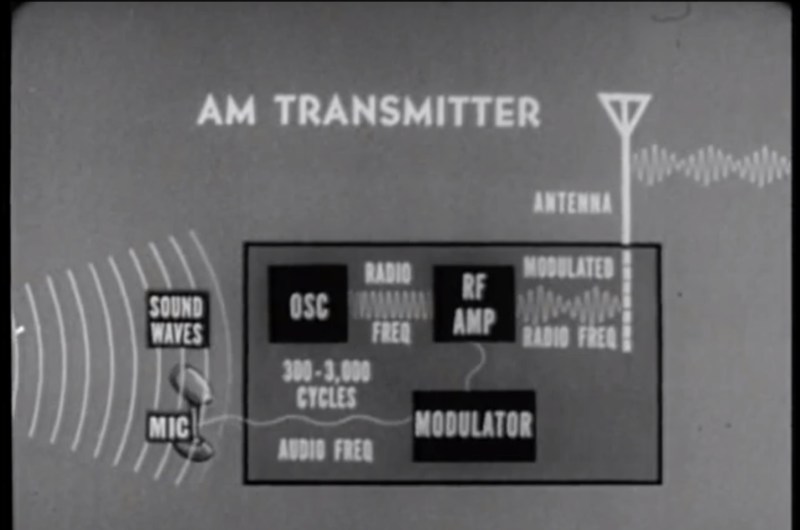How radios send and receive information can seem magical to the uninformed. For some people, this week’s Retrotechtacular video, “Frequency Modulation – Part 1 Basic Principles”, from the US Army Department of Defense 1964 will be a great refresher, and for others it will be their first introduction into the wonderful world of radio communications.
The stated objective is to teach why FM radio communication reduces interference which normally afflicts AM radio communications. Fundamentals of AM and FM is a better description, however, because the first part of the video nicely teaches the principles of AM and FM radio communications. It isn’t until later in the clip that it delves into interference, advantages of FM modulation, and detailed functioning of FM radio. The delivery is slow at times and admittedly long, yet the pace is perfect for a young ham to follow along with plenty of time to soak in the knowledge. If you’re still on the fence about becoming a ham here’s some words or encouragement.
Though the video isn’t aimed at ham radio users it does address core knowledge needed by amateur radio hobbyists. Amateur radio is full of many exciting communication technologies and you should have a clear understanding of AM and FM communication methodologies before getting on Grandpa’s information super highway. Once you have your ham license (aka ticket) you have privileges to create and test amazing ham related hacks, like [Lior] implementing full programmable control of a Baofeng UV5R ham radio using an Arduino.
Join us after the break to watch the video.
The video comes to us from public.resource.org and community member [Wybren Buijs] on the tip line.















Why the sudden amateur radio ‘push’ on Hackaday lately? I’m a ham and welcome promotion of the hobby but just find it odd.
I’m all for it. Arduino hacks are fine and all, but RF is pretty much the next level of electronics know-how.
I suppose it’s because people see one article and then go looking for more information on that subject. If it’s interesting, you’ll keep learning.
This is more general than just ham. Anyone interested in WiFi, Bluetooth, XBee, cable television distribution, cell phone tech, GPS, and all manners of radio technology benefit from a good RF foundation.
I’m new to the team and ham is one of my side hobbies.
Although I happen to be a ham, one thing I’ve noticed on HAD for a long time is that general topics seem to come in streaks. Nothing in perticular seems to trigger it, but once there are two posts on a general topic within a day or two, we’ll see that general topic several more times in the next week or so.
Keep these retro info videos coming. They are better than most any other explanation I have seen.
I second this, the Retro Tech videos are pretty good
I’ll third it. Keem ’em coming!
Could be wrong, but I think in that diagram he’s got the RF amp and the modulator mixed up. The carrier wave from OSC should be feeding into the modulator too right?
No, that diagram is for AM and you generally modulate the final RF amp for that.
So what’s the box marked “modulator” doing then? The only thing I can think of is maybe a mic amp.
maybe watch the video and find out?
Yes, the modulator is an audio amplifier. The modulator takes the audio signal pushes it up to significant wattage and this energy is added to the RF in the output stage.
For more on this look up “plate modulation”. The modulator is essentially varying the power supply voltage to the final stage of the RF amp at audio frequency and with varying amplitude.
Yep, it’s a rather big difference actually.
Love this post- reminds me of the time I was a kid and got free parts from a local auto-store on a bet that I could change the music that was playing over their radio without physical access. (used a simple tunable fm transmitter I built coupled with the main board of a diamond rio PMP300 for audio input)
I wonder if there are any of these type of video on optics.
Altough they killed a lot of people, they made some good videos.
For anyone who goes looking for the part 2 to this, all parts are actually already in this video. Part 2 is just the last 10 minutes or so of this video.
As for why content seems to follows a theme on HAD, I worked for a company where I had to write something new and interesting every single day and it gets difficult after a while to come up with decent content.
It’s my guess that they gather resources in large chunks on a particular topic then refine the content down into several posts. I know this technique made my job much easier when I had to do it.
Just my 2 cents
Nobody wants 300 of those videos at once, it’s just better to have them occasionally.